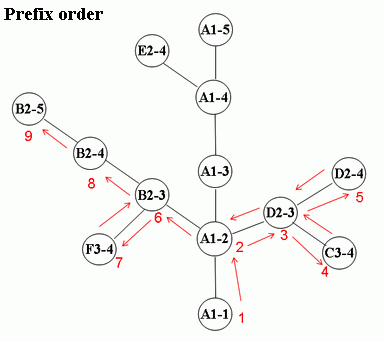GreenLab Course
Development
Tree traversal
When generating a simulated tree structure, computational approaches do in fact generate a tree graph.
The way the process accesses to the componants of this tree graph (and construct it), known as tree traversal, plays a key role in the properties of the simulated structure.
Tree structure traversal
-
In most structural and functional-structural plant models, the plant structure is built from phytomer
linkages according to a simulated growing process.
Phytomers are connected to each other (on the same axis or when branching), building an oriented graph, from the seed to the leaves.
Simulation of the growth process is thus a dynamic scheme integrating new (nodes) phytomers at end of axis lists, or adding new pathways (new axes on axillaries) to existing nodes.
However, implementation of this growth process can be quite different from what happens in nature.
Two main strategies can be found in the literature:
- - Building the structure step by step, trying to mimic natural growth.
This approach is popular for FSPM, but is costly, especially for applications where periods of interest (harvest) will require use of the full structural plant history.
- Building the structure at a given specific age, known from outset.
This approach is popular in structural approaches, and is usually efficient (since intermediate stages are not explicitly considered).
Implementation in FSPM is, in this case, more difficult, since the history must be considered when building the structure.
Note that, when considering stochastic structures, for applications at stand level, both approaches require the building of a significant set of simulated structures, leading to significant computational and memory costs.
Another point is that, in both cases, the construction of the structure, built by a mathematical tree transversal path, may not reflect growth dynamics, as illustrated below.

Various tree traversal construction methods (Drawings M. Jaeger, CIRAD)
- ( Click on < and > buttons to visualize the various traversals).
Prefix order is fast with low spatial cost. Only the last step is faifthful to living plant development.
Hierarchical order is effective for visualization. Only the last step is faifthful to real plant development.
Level Order is the closest to real plants development. Note, however, that phytomers appearing in the same cycle should be processed simultaneously.
In GreenLab model implementations, the preferred construction mode is a Prefix order transversal construction.
